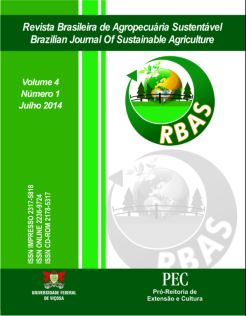MORPHOGENESIS AND STRUCTURE MASSAIGRASS IN DIFFERENT CROPPING SYSTEMS UNDER GRAZING
DOI:
https://doi.org/10.21206/rbas.v4i1.233Abstract
The objective was to evaluate the morphogenetic and structural characteristics of massaigrass monoculture, silvopastoral system (massaigrass and cashew; massaigrass, cashew and estilosantes cv. Campo Grande, grazing by sheep). The experiment was conducted at the experimental field of Embrapa Meio-Norte in Teresina-PI, in the months from March to July of 2012. It was adopted completely randomized design with three treatments (monoculture massaigrass, silvopastoral of massaigrass with cashew and silvopastoral of massaigrass with cashew and estilosantes), four replications (paddocks) and split plot (grazing cycles). Ten tillers were marked at random into four paddocks that were randomly selected from a total of ten, totaling forty tillers per treatment. The evaluations were performed every three days, where the appearance of the leaf apex, the length of the stem, the leaf blade length, the number of green, dead and senescent leaves were recorded. Effect of interaction between systems and grazing cycles only for stem elongation rate (SER), phyllochron (phyl) and the final leaf length (FLL) was observed. Leaf appearance rate (LAR) and the total number of upper leaves (NTF) in monoculture massaigrass were observed. The phyllochron was higher in the silvopastoral system with estilosantes (9.964 days). Leaf elongation rate (LER) and final leaf length (FLL) higher in shaded treatments was observed. No differences for the rate of leaf senescence (RLS) and life span of leaves (LSL) the number of green leaves (NGL), number of leaves in senescence (NLS) and number of dead leaves (NDL) were observed. The total number of leaves (TNL) was higher in the monoculture system (3.6125 leaves.tiller-1) compared to the shaded treatments (3.137 and 2.987 leaves.tiller-1). The variations of the luminous intensity of treatments influence morphogenesis and structure of massaigrass.Downloads
Download data is not yet available.
Downloads
Published
2014-07-01
How to Cite
de Carvalho, W. F., de Moura, R. L., dos Santos, M. S., Silva, S. F., & Leal, T. M. (2014). MORPHOGENESIS AND STRUCTURE MASSAIGRASS IN DIFFERENT CROPPING SYSTEMS UNDER GRAZING. Brazilian Journal of Sustainable Agriculture, 4(1). https://doi.org/10.21206/rbas.v4i1.233
Issue
Section
Artigos
License
1. Proposta de Política para Periódicos de Acesso Livre
Autores que publicam nesta revista concordam com os seguintes termos:
Autores mantém os direitos autorais e concedem à revista o direito de primeira publicação, com o trabalho simultaneamente licenciado sob a Licença Creative Commons Attribution que permite o compartilhamento do trabalho com reconhecimento da autoria e publicação inicial nesta revista.












